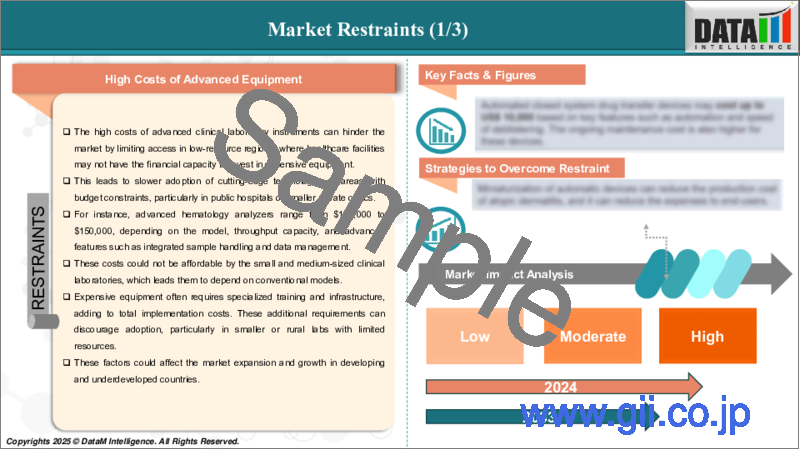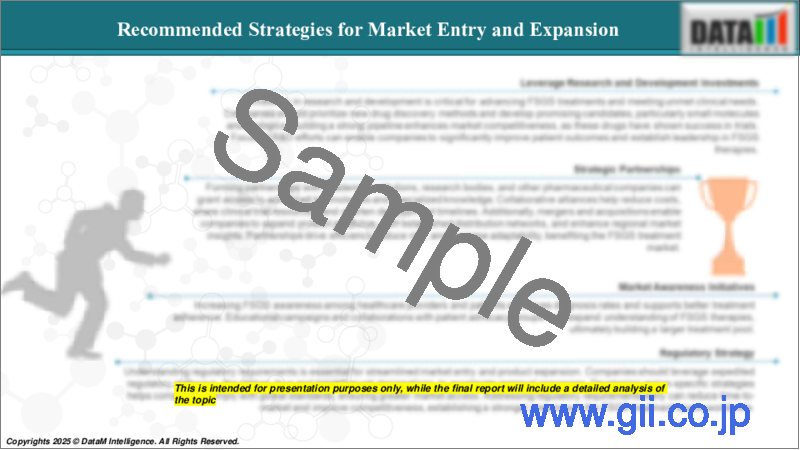|
|
市場調査レポート
商品コード
1678787
臨床検査機器の世界市場 (2025年~2033年)Global Clinical Laboratory Instruments Market - 2025-2033 |
||||||
カスタマイズ可能
適宜更新あり
|
|||||||
| 臨床検査機器の世界市場 (2025年~2033年) |
|
出版日: 2025年03月11日
発行: DataM Intelligence
ページ情報: 英文 176 Pages
納期: 即日から翌営業日
|
- 全表示
- 概要
- 目次
世界の臨床検査機器市場は、2024年に485億5,000万米ドルに達し、2033年には916億1,000万米ドルに達すると予測され、予測期間2025年にはCAGR 7.4%で成長すると予測されています。
臨床検査機器は、さまざまな疾患の診断、モニタリング、治療に役立つ幅広い検査を実施するために、医療検査室で使用される不可欠なツールです。これらの機器には、血液分析装置、臨床化学分析装置、免疫測定分析装置、顕微鏡、分子診断装置など、幅広い機器が含まれます。血液検査、組織分析、病原体や特定のバイオマーカーの検出など、重要な機能を果たします。
市場力学:
促進要因と抑制要因
技術進歩の高まり
技術進歩の高まりは、診断検査の効率性、正確性、迅速性を向上させることにより、予測期間中に臨床検査機器市場を大きく牽引すると予想されます。自動化、人工知能(AI)の統合、次世代シーケンシング(NGS)、ポイントオブケア(POC)デバイスなどの革新は、検査室業務に革命をもたらしています。
さらに、分子診断や遺伝子検査の進歩により、様々な疾患の早期発見や個別化治療が可能になり、特殊な機器に対する需要が高まっています。技術の継続的な向上により、臨床検査室はより効率的になっており、その結果、先進的な機器の採用が増加し、臨床検査機器市場の成長に拍車をかけています。
例えば、2024年6月、堀場製作所は受賞歴のある小型血液検査機器シリーズを拡充し、赤血球沈降速度(ESR)を搭載した新モデルを発表しました。新しいYumizen H550E(オートローダー)、H500E CT(クローズドチューブ)、Yumizen H500E OT(オープンチューブ)は、全血から60秒でCBC/DIFFとESRの結果が得られる複合検査を提供し、すでに機器の豊富な機能に炎症性疾患評価のための包括的なプロファイルを追加します。
高度な臨床検査機器の高いコスト
先進的な臨床検査機器の高額なコストは、医療施設が高価な機器に投資する経済力を持たない低資源地域でのアクセスを制限し、市場の妨げとなる可能性があります。このため、予算に制約のある地域、特に公立病院や小規模の民間診療所では、最先端技術の導入が遅れることになります。
目次
第1章 分析手法と分析範囲
第2章 定義と概要
第3章 エグゼクティブサマリー
第4章 市場力学
- 影響要因
- 促進要因
- 技術的進歩
- 医療インフラへの投資増加
- 抑制要因
- 高度な機器の高コスト
- メンテナンスと校正の複雑さ
- 機会
- ポイントオブケア(POC)診断の需要増加
- 影響分析
- 促進要因
第5章 産業分析
- 市場のリーダーと先駆者
- 新たな先駆者と主要企業
- 最大の売上を誇るブランドを確立したリーダー
- 確立された製品を持つ市場リーダー
- CXOの視点
- 最新の開発とブレークスルー
- ケーススタディ/進行中の研究
- 規制と償還の情勢
- 北米
- 欧州
- アジア太平洋
- ラテンアメリカ
- 中東・アフリカ
- ポーターのファイブフォース分析
- サプライチェーン分析
- 特許分析
- SWOT分析
- アンメットニーズとギャップ
- 市場参入と拡大のための推奨戦略
- シナリオ分析:ベストケース・ベースケース・ワーストケースの予測
- 価格分析と価格市場力学
- キーオピニオンリーダー (KOL)
第6章 種類別
- 自動
- 半自動
- 手動
第7章 製品種類別
- 臨床化学機器
- 血液分析装置
- 免疫測定機器
- 微生物学機器
- 分子診断機器
- 血液ガス・電解質分析装置
- ポイントオブケア(POC)装置
- その他
第8章 エンドユーザー別
- 病院
- 診断検査室
- 学術研究機関
- クリニック・外来手術センター
第9章 地域別
- 北米
- 米国
- カナダ
- メキシコ
- 欧州
- ドイツ
- 英国
- フランス
- スペイン
- イタリア
- その他欧州地域
- 南米
- ブラジル
- アルゼンチン
- その他南米
- アジア太平洋
- 中国
- インド
- 日本
- 韓国
- その他アジア太平洋地域
- 中東・アフリカ
第10章 競合情勢
- 競合シナリオ
- 市況・シェア分析
- M&A分析
第11章 企業プロファイル
- Beckman Coulter, Inc.
- 企業概要
- 製品ポートフォリオ
- 製品説明
- 製品の主要業績評価指標(KPI)
- 製品販売の実績・予測
- 製品販売量
- 財務概要
- 企業の収益
- 収益シェア:地域別
- 収益予測
- 主な動向
- 企業合併・買収 (M&A)
- 主な製品開発活動
- 規制当局の承認等
- SWOT分析
- Thermo Fisher Scientific Inc.
- Shenzhen Mindray Bio-Medical Electronics Co., Ltd.
- Siemens Healthineers AG
- bioMerieux
- Leica Microsystems
- Abbott Laboratories
- Roche Diagnostics
- Transasia Bio-Medicals
- Labtron Equipment Ltd.
第12章 付録
The global clinical laboratory instruments market reached US$ 48.55 billion in 2024 and is expected to reach US$ 91.61 billion by 2033, growing at a CAGR of 7.4% during the forecast period 2025-2033.
Clinical laboratory instruments are essential tools used in medical laboratories to conduct a wide range of tests that help in diagnosing, monitoring, and treating various diseases. These instruments encompass a broad spectrum of devices, including hematology analyzers, clinical chemistry analyzers, immunoassay analyzers, microscopes, and molecular diagnostic equipment. They perform critical functions such as blood testing, tissue analysis, and the detection of pathogens or specific biomarkers.
Market Dynamics: Drivers & Restraints
Rising Technological Advancements
Rising technological advancements are expected to significantly drive the clinical laboratory instruments market over the forecast period by improving the efficiency, accuracy and speed of diagnostic testing. Innovations such as automation, artificial intelligence (AI) integration, next-generation sequencing (NGS) and point-of-care (POC) devices are revolutionizing laboratory operations.
Additionally, advancements in molecular diagnostics and genetic testing are enabling earlier detection and personalized treatment for various diseases, driving demand for specialized instruments. With continuous improvements in technology, clinical laboratories are becoming more efficient, which in turn increases the adoption of advanced instruments, thereby fueling the growth of the clinical laboratory instruments market.
For instance, in June 2024, HORIBA expanded its award-winning compact hematology instrument range with the launch of new models with the Erythrocyte Sedimentation Rate (ESR) on board. The new Yumizen H550E (autoloader), H500E CT (closed tube), and Yumizen H500E OT (open tube) offer combined testing for CBC/DIFF with ESR results from whole blood in 60 seconds, adding a comprehensive profile for inflammatory disease assessment to the instruments' already extensive functionality.
High Costs of Advanced Clinical Laboratory Instruments
The high costs of advanced clinical laboratory instruments can hinder the market by limiting access in low-resource regions, where healthcare facilities may not have the financial capacity to invest in expensive equipment. This leads to slower adoption of cutting-edge technologies in areas with budget constraints, particularly in public hospitals or smaller private clinics.
Segment Analysis
The global clinical laboratory instruments market is segmented based on the type, product type, end-user and region.
Clinical chemistry instruments in the product type segment are expected to dominate the clinical laboratory instruments market with the highest market share.
The clinical chemistry instruments segment is expected to dominate the clinical laboratory instruments market due to their broad application in routine diagnostics and the growing prevalence of chronic diseases like diabetes, cardiovascular conditions, and kidney disorders. These instruments are essential for testing a wide range of substances such as glucose, cholesterol, proteins, and electrolytes, making them indispensable in diagnosing and monitoring various health conditions.
Additionally, technological advancements in automation have significantly improved the speed, accuracy, and efficiency of clinical chemistry analyzers, enabling high-throughput testing, reducing human error, and lowering operational costs.
For instance, Beckman Coulter Diagnostics will unveil its new DxC 500 AU Chemistry Analyzer, an automated clinical chemistry analyzer. The DxC 500 AU Chemistry Analyzer is one of several recent Beckman Coulter solutions designed to address the complete needs of healthcare systems that are looking to complement central hub laboratories by advancing the technology and capabilities of satellite and independent hospital laboratories. This makes clinical chemistry instruments vital in both high-volume hospital settings and smaller laboratories, ensuring their dominance in the market.
Geographical Analysis
North America is expected to dominate the clinical laboratory instruments market with highest market share
North America is expected to dominate the clinical laboratory instruments market due to its advanced healthcare infrastructure, strong presence of leading manufacturers, and substantial investments in healthcare. The region benefits from a high demand for diagnostic testing driven by the aging population, rising incidence of chronic diseases, and a focus on personalized medicine.
Technological advancements, including the adoption of molecular diagnostics, automated systems, and point-of-care devices, further bolster market growth. The robust regulatory framework, including FDA approvals, ensures high-quality standards for clinical laboratory instruments, while the region's strong research ecosystem, including top academic and clinical research institutions, drives continuous innovation.
For instance, in March 2023, PerkinElmer's Oxford Immunotec received the U.S. FDA approval for two additional cell isolation instruments, the Auto-Pure 24 and Auto-Pure 20B, for use with its T-Cell Select reagent kit in the T-SPOT.TB test workflow. All these factors combined ensure North America's continued dominance in the clinical laboratory instruments market.
Competitive Landscape
The global market players in the clinical laboratory instruments market are Beckman Coulter, Inc., Thermo Fisher Scientific Inc., Shenzhen Mindray Bio-Medical Electronics Co., Ltd., Siemens Healthineers AG, bioMerieux, Leica Microsystems, Abbott Laboratories, Roche Diagnostics, Transasia Bio-Medicals and Labtron Equipment Ltd., among others.
Key Developments
- In April 2023, Waters Corporation unveiled its next-generation Xevo TQ Absolute IVD mass spectrometer, expanding its family of MassTrak IVD LC-MS/MS Systems for clinical diagnostic applications.
- In June 2024, Thermo Fisher Scientific introduced a new mass spectrometry platform, in addition to several updates to existing products at the American Society for Mass Spectrometry (ASMS) conference in Anaheim.
Why Purchase the Report?
- Pipeline & Innovations: Reviews ongoing clinical trials, and product pipelines, and forecasts upcoming pharmaceutical advancements.
- Type Performance & Market Positioning: Analyzes product performance, market positioning, and growth potential to optimize strategies.
- Real-World Evidence: Integrates patient feedback and data into product development for improved outcomes.
- Physician Preferences & Health System Impact: Examines healthcare provider behaviors and the impact of health system mergers on adoption strategies.
- Market Updates & Industry Changes: Covers recent regulatory changes, new policies, and emerging technologies.
- Competitive Strategies: Analyzes competitor strategies, market share, and emerging players.
- Pricing & Market Access: Reviews pricing models, reimbursement trends, and market access strategies.
- Market Entry & Expansion: Identifies optimal strategies for entering new markets and partnerships.
- Regional Growth & Investment: Highlights high-growth regions and investment opportunities.
- Supply Chain Optimization: Assesses supply chain risks and distribution strategies for efficient Type delivery.
- Sustainability & Regulatory Impact: Focuses on eco-friendly practices and evolving regulations in healthcare.
- Post-market Surveillance: Uses post-market data to enhance product safety and access.
- Pharmacoeconomics & Value-Based Pricing: Analyzes the shift to value-based pricing and data-driven decision-making in R&D.
The global clinical laboratory instruments market report delivers a detailed analysis with 45 key tables, more than 46 visually impactful figures, and 176 pages of expert insights, providing a complete view of the market landscape.
Target Audience 2024
- Manufacturers: Pharmaceutical, Biotech Companies, Contract Manufacturers, Distributors, Hospitals.
- Regulatory & Policy: Compliance Officers, Government, Health Economists, Market Access Specialists.
- Technology & Innovation: R&D Professionals, Clinical Trial Managers, Pharmacovigilance Experts.
- Investors: Healthcare Investors, Venture Fund Investors, Pharma Marketing & Sales.
- Consulting & Advisory: Healthcare Consultants, Industry Associations, Analysts.
- Supply Chain: Distribution and Supply Chain Managers.
- Consumers & Advocacy: Patients, Advocacy Groups, Insurance Companies.
- Academic & Research: Academic Institutions.
Table of Contents
1. Methodology and Scope
- 1.1. Research Methodology
- 1.2. Research Objective and Scope of the Report
2. Definition and Overview
3. Executive Summary
- 3.1. Snippet by Type
- 3.2. Snippet by Product Type
- 3.3. Snippet by End-User
- 3.4. Snippet by Region
4. Dynamics
- 4.1. Impacting Factors
- 4.1.1. Drivers
- 4.1.1.1. Technological Advancements
- 4.1.1.2. Increased Investment in Healthcare Infrastructure
- 4.1.2. Restraints
- 4.1.2.1. High Costs of Advanced Equipment
- 4.1.2.2. Complexity of Maintenance and Calibration
- 4.1.3. Opportunities
- 4.1.3.1. Increasing Demand for Point-of-Care (POC) Diagnostics
- 4.1.4. Impact Analysis
- 4.1.1. Drivers
5. Industry Analysis
- 5.1. Market Leaders and Pioneers
- 5.2. Emerging Pioneers and Prominent Players
- 5.3. Established leaders with largest selling Brand
- 5.4. Market leaders with established Product
- 5.5. CXO Perspectives
- 5.6. Latest Developments and Breakthroughs
- 5.7. Case Studies/Ongoing Research
- 5.8. Regulatory and Reimbursement Landscape
- 5.9. North America
- 5.10. Europe
- 5.11. Asia Pacific
- 5.12. Latin America
- 5.13. Middle East & Africa
- 5.14. Porter's Five Force Analysis
- 5.15. Supply Chain Analysis
- 5.16. Patent Analysis
- 5.17. SWOT Analysis
- 5.18. Unmet Needs and Gaps
- 5.19. Recommended Strategies for Market Entry and Expansion
- 5.20. Scenario Analysis: Best-Case, Base-Case, and Worst-Case Forecasts
- 5.21. Pricing Analysis and Price Dynamics
- 5.22. Key Opinion Leaders
6. By Type
- 6.1. Introduction
- 6.1.1. Market Size Analysis and Y-o-Y Growth Analysis (%), By Type
- 6.1.2. Market Attractiveness Index, By Type
- 6.2. Automated*
- 6.2.1. Introduction
- 6.2.2. Market Size Analysis and Y-o-Y Growth Analysis (%)
- 6.3. Semi-automated
- 6.4. Manual
7. By Product Type
- 7.1. Introduction
- 7.1.1. Market Size Analysis and Y-o-Y Growth Analysis (%), By Product Type
- 7.1.2. Market Attractiveness Index, By Product Type
- 7.2. Clinical Chemistry Instruments*
- 7.2.1. Introduction
- 7.2.2. Market Size Analysis and Y-o-Y Growth Analysis (%)
- 7.3. Hematology Analyzers
- 7.4. Immunoassay Instruments
- 7.5. Microbiology Instruments
- 7.6. Molecular Diagnostics Instruments
- 7.7. Blood Gas & Electrolyte Analyzers
- 7.8. Point-of-Care (POC) Devices
- 7.9. Others
8. By End-User
- 8.1. Introduction
- 8.1.1. Market Size Analysis and Y-o-Y Growth Analysis (%), By Application
- 8.1.2. Market Attractiveness Index, By Application
- 8.2. Hospitals*
- 8.2.1. Introduction
- 8.2.2. Market Size Analysis and Y-o-Y Growth Analysis (%)
- 8.3. Diagnostic Laboratories
- 8.4. Academic & Research Institutes
- 8.5. Clinics & Ambulatory Surgical Centers
9. By Region
- 9.1. Introduction
- 9.1.1. Market Size Analysis and Y-o-Y Growth Analysis (%), By Region
- 9.1.2. Market Attractiveness Index, By Region
- 9.2. North America
- 9.2.1. Introduction
- 9.2.2. Key Region-Specific Dynamics
- 9.2.3. Market Size Analysis and Y-o-Y Growth Analysis (%), By Type
- 9.2.4. Market Size Analysis and Y-o-Y Growth Analysis (%), By Product Type
- 9.2.5. Market Size Analysis and Y-o-Y Growth Analysis (%), By End-User
- 9.2.6. Market Size Analysis and Y-o-Y Growth Analysis (%), By Country
- 9.2.6.1. U.S.
- 9.2.6.2. Canada
- 9.2.6.3. Mexico
- 9.3. Europe
- 9.3.1. Introduction
- 9.3.2. Key Region-Specific Dynamics
- 9.3.3. Market Size Analysis and Y-o-Y Growth Analysis (%), By Type
- 9.3.4. Market Size Analysis and Y-o-Y Growth Analysis (%), By Product Type
- 9.3.5. Market Size Analysis and Y-o-Y Growth Analysis (%), By End-User
- 9.3.6. Market Size Analysis and Y-o-Y Growth Analysis (%), By Country
- 9.3.6.1. Germany
- 9.3.6.2. U.K.
- 9.3.6.3. France
- 9.3.6.4. Spain
- 9.3.6.5. Italy
- 9.3.6.6. Rest of Europe
- 9.4. South America
- 9.4.1. Introduction
- 9.4.2. Key Region-Specific Dynamics
- 9.4.3. Market Size Analysis and Y-o-Y Growth Analysis (%), By Type
- 9.4.4. Market Size Analysis and Y-o-Y Growth Analysis (%), By Product Type
- 9.4.5. Market Size Analysis and Y-o-Y Growth Analysis (%), By End-User
- 9.4.6. Market Size Analysis and Y-o-Y Growth Analysis (%), By Country
- 9.4.6.1. Brazil
- 9.4.6.2. Argentina
- 9.4.6.3. Rest of South America
- 9.5. Asia-Pacific
- 9.5.1. Introduction
- 9.5.2. Key Region-Specific Dynamics
- 9.5.3. Market Size Analysis and Y-o-Y Growth Analysis (%), By Type
- 9.5.4. Market Size Analysis and Y-o-Y Growth Analysis (%), By Product Type
- 9.5.5. Market Size Analysis and Y-o-Y Growth Analysis (%), By End-User
- 9.5.6. Market Size Analysis and Y-o-Y Growth Analysis (%), By Country
- 9.5.6.1. China
- 9.5.6.2. India
- 9.5.6.3. Japan
- 9.5.6.4. South Korea
- 9.5.6.5. Rest of Asia-Pacific
- 9.6. Middle East and Africa
- 9.6.1. Introduction
- 9.6.2. Key Region-Specific Dynamics
- 9.6.3. Market Size Analysis and Y-o-Y Growth Analysis (%), By Type
- 9.6.4. Market Size Analysis and Y-o-Y Growth Analysis (%), By Product Type
- 9.6.5. Market Size Analysis and Y-o-Y Growth Analysis (%), By End-User
10. Competitive Landscape
- 10.1. Competitive Scenario
- 10.2. Market Positioning/Share Analysis
- 10.3. Mergers and Acquisitions Analysis
11. Company Profiles
- 11.1. Beckman Coulter, Inc.*
- 11.1.1. Company Overview
- 11.1.2. Product Portfolio
- 11.1.2.1. Product Description
- 11.1.2.2. Product Key Performance Indicators (KPIs)
- 11.1.2.3. Historic and Forecasted Product Sales
- 11.1.2.4. Product Sales Volume
- 11.1.3. Financial Overview
- 11.1.3.1. Company Revenue's
- 11.1.3.2. Geographical Revenue Shares
- 11.1.3.3. Revenue Forecasts
- 11.1.4. Key Developments
- 11.1.4.1. Mergers & Acquisitions
- 11.1.4.2. Key Product Development Activities
- 11.1.4.3. Regulatory Approvals etc.
- 11.1.5. SWOT Analysis
- 11.2. Thermo Fisher Scientific Inc.
- 11.3. Shenzhen Mindray Bio-Medical Electronics Co., Ltd.
- 11.4. Siemens Healthineers AG
- 11.5. bioMerieux
- 11.6. Leica Microsystems
- 11.7. Abbott Laboratories
- 11.8. Roche Diagnostics
- 11.9. Transasia Bio-Medicals
- 11.10. Labtron Equipment Ltd.
LIST NOT EXHAUSTIVE
12. Appendix
- 12.1. About Us and Services
- 12.2. Contact Us






